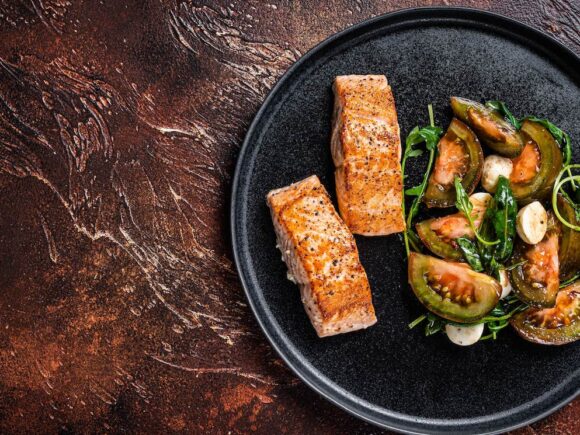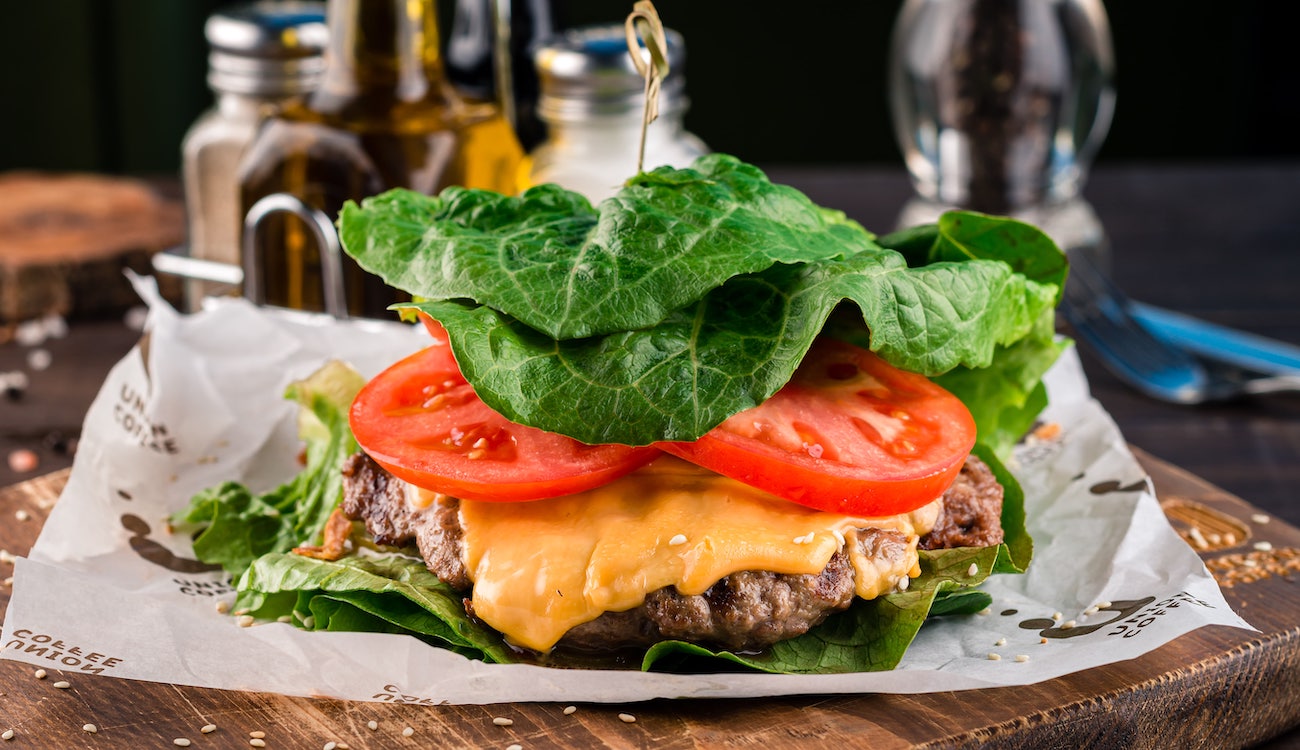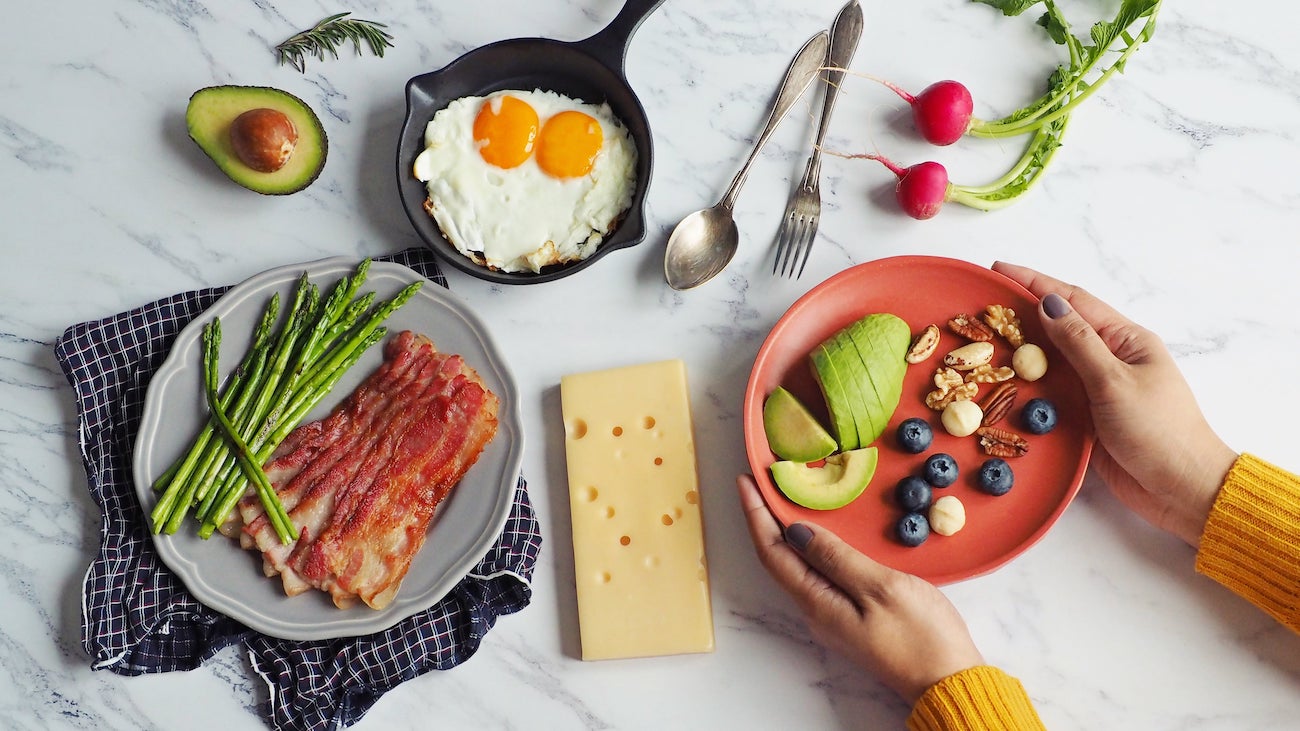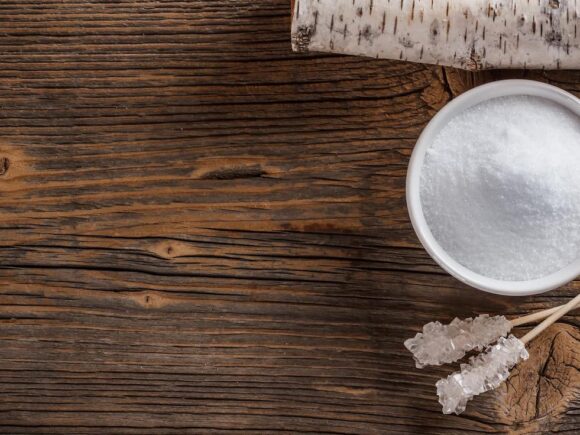Gluten-Free Low-Carb Diet: All You Need to Know


Gluten-free diets and gluten-free products are becoming increasingly popular among people with and without celiac disease and gluten sensitivity. However, some people go further and choose only low-carb foods that are also gluten-free.
Let’s learn more about the gluten-free, low-carb diet, what foods you should choose and avoid, and explore a simple meal plan you can follow.
Gluten-Free Diet and Low-Carb Diet: What’s the Difference?
A gluten-free diet and a low-carb diet both aim to restrict the intake of certain carbohydrates. However, they are different diets with different goals.
A gluten-free diet eliminates products that contain gluten, such as wheat, rye, barley, and other whole grains, and may replace them with gluten-free alternatives. It’s designed for people with celiac disease or gluten sensitivity. A person on a gluten-free diet may still consume a moderate amount of high-carb foods as long as these foods are gluten-free.
A gluten-free diet has a range of benefits, such as:
- reduced bloating
- ability to maintain a healthy weight and prevent weight gain
- eliminating processed foods, packaged foods, and refined grains from the diet
- higher consumption of fruits and vegetables
- better joint and bone health
Meanwhile, a low-carb diet doesn’t target a specific type of carbohydrate but instead reduces the overall amount of carbohydrates consumed. There are several types of low-carb diets. Some of the most popular include Atkins, paleo, and the ketogenic diet.
Some of the key benefits of a low-carb diet are:
- weight loss
- reduced blood glucose levels and improved insulin resistance
- type 2 diabetes management
- lowered high cholesterol
- reduced triglycerides
- improved good and bad cholesterol levels
While a gluten-free diet and a low-carbohydrate diet are two distinct types of diets, it’s possible to benefit from combining them.
Is Keto Gluten-Free?
Inherently, the keto diet is not gluten-free, but it can be adapted to be gluten-free. The main principle of the ketogenic diet is to consume foods that are low in carbohydrates and high in healthy fats. Many naturally gluten-free foods, such as meats, fish, eggs, vegetables, and nuts, are compatible with the keto diet. However, some keto-friendly processed foods, such as certain low-carb snacks or packaged keto products, may contain gluten ingredients. If you are following a gluten-free diet and also want to incorporate keto principles, it’s important to carefully read labels and choose gluten-free options.
Gluten-Free Low-Carb Foods
If you would like to benefit from both a gluten-free and a low-carb diet, you’ll find that it’s actually surprisingly easy and straightforward to identify foods that you should and shouldn’t eat. First, you should avoid gluten-containing foods like:
- wheat and wheat derivatives like semolina, couscous, farina, kamut, farro, durum, spelt, bulgur, wheat bran, wheat berries, wheat starch, einkorn, and similar
- barley
- rye
- seitan, which is a common ingredient in plant-based foods like meat substitutes
- triticale, which is a hybrid of wheat and rye
- malt and malt derivatives
- brewer’s yeast
Since many packaged goods like cookies, pizza dough, pasta, and bread contain gluten, it’s paramount to read labels when shopping. Luckily, the law in most Western countries requires food manufacturers to identify allergens on labels.
In addition, as part of a gluten-free, low-carb diet, you should avoid high-carb foods:
- starchy vegetables such as corn, potatoes, sweet potatoes, turnips, yams, and beets
- beans and legumes
- gluten-free whole grains like rice and oats
- gluten-free flour, such as rice, potato, bean, and lentil flour
- low-fat and fat-free products, such as salad dressings, as they contain more sugar and carbs to compensate for the lack of fat
- fruit juices
- high-sugar fruits like grapes, mangoes, figs, and pears
- sweetened yogurts
- baked gluten-free goods
- alcohol, especially beer
- honey and sugar
Now that you know what not to eat to avoid gluten and carbs, what can you eat on a gluten-free, low-carb diet? These are the foods you should look for:
- meat and poultry
- eggs
- fish and shellfish
- tofu, tempeh, and soy sauce
- cheese
- nuts and seeds
- non-starchy vegetables such as bell peppers, broccoli, leafy greens, and zucchini
- low-sugar fruits like strawberries, raspberries, blackberries, avocadoes, and kiwi
Generally, aim for nutritious high-fat and high-protein foods.
How to Eat Low-Carb on a Gluten-Free Diet?
If you are on a gluten-free diet and want to go low-carb, here are some guidelines to follow:
Prioritize your protein intake
Protein is a key micronutrient in a low-carb diet. Not only is it essential for optimal health, but it also helps you feel fuller for longer. Making sure you get plenty of protein also makes it easier to avoid eating carbohydrates.
Consume healthy animal and plant-based fats
Low-carb diets like the keto diet require fats for energy. It’s important to choose healthy fats like avocados, olive oil, nuts, and fish.
Limit your carb intake
All low-carb diets restrict carbohydrate intake. However, each has slightly different requirements, with the keto diet being the most restrictive. It limits your carbohydrate intake to 50 grams per day. While gluten-free diets already cut out most carbs by eliminating gluten, there are still many gluten-free foods that are high in carbs. You may want to limit your intake of foods such as rice, beans, lentils, and the like. You might find it helpful to track your carbohydrate intake to make sure you’re staying within your limits.
Eat plenty of non-starchy vegetables
Non-starchy vegetables are low-carb. So it’s safe to eat them as part of your low-carb diet plan. In fact, eating fruits and vegetables on a regular basis is necessary for healthy digestion. They contain fiber, which aids in bowel movements and helps protect the lining of the small intestine.
Stick to water
Fruit juices and carbonated drinks are notoriously high in sugar and can lead to weight gain. So, when following a low-carb diet, you can avoid a lot of carbohydrates if you only drink water.
The following steps will ensure that your diet is not only gluten-free but also low-carb.
Is a Gluten-Free, Low-Carb Diet Safe?
The primary reason why people avoid gluten and follow a gluten-free low-carb diet is gluten sensitivity and celiac disease.
Celiac disease is an autoimmune response that causes the body to attack its own tissue after consuming gluten. This damages the small intestine, making it harder for the body to absorb nutrients. Only a small percentage of people suffer from celiac disease, and even those with a genetic predisposition to it may not develop it.
Non-celiac gluten sensitivity, also referred to as gluten intolerance, presents similar symptoms and makes you sick if you consume gluten. Therefore, avoiding gluten is not only safe but essential for these individuals.
Wheat allergy is another health condition that can benefit from avoiding gluten. While people with wheat allergy can still consume non-wheat gluten-containing foods such as rye and barley, wheat products are much more common, and a gluten-free diet can be a convenient option. In addition, people with irritable bowel syndrome may experience reduced symptoms on a gluten-free diet.
Gluten-Free, Low-Carb Diet for Non-Celiac Individuals
In recent years, however, gluten-free diets have become increasingly popular among people who do not have celiac disease or non-celiac gluten sensitivity. They believe that a gluten-free diet is healthy and can promote weight loss and other health benefits.
Despite this common belief, weight loss in these individuals is usually an indirect benefit. Because many gluten-containing foods are refined carbohydrates, eliminating gluten leads to healthier food choices that promote weight loss.
In addition, medical professionals warn that gluten-containing foods are rich in fiber and micronutrients such as vitamin B, iron, and magnesium. So if you’re following a gluten-free diet, it’s important to make sure you’re getting these nutrients from other foods.
So while a gluten-free diet is essential for people with celiac disease or gluten sensitivity, it’s generally safe but not necessary for people without these issues to go gluten-free.
Gluten-Free Low-Carb Diet Meal Plan
Low-carb and gluten-free diets eliminate certain foods. Therefore, preparing your meal plans and meals ahead of time can help you stay on track and consistently include whole foods in your meals, maintain weight loss, and keep blood glucose levels stable.
To get you started, we’ve put together a complete 1-week low-carb, gluten-free meal plan.
Day 1
Breakfast: Mascarpone Raspberry Peanut Butter Smoothie (361.91kcal)
This quick and creamy mascarpone and nut butter shake gives you a healthy dose of protein and fat. Meanwhile, raspberries add a unique flavor while providing you with vitamins C, A, and E, folate, and antioxidants.
Morning snack: Cheese (120.89kcal)
- ⅓ cup cheddar cheese, cubed
Lunch: Salmon With Bell Pepper (480.58kcal)
Salmon is a great staple of the keto diet. It’s rich in fat, protein, DHA, and vitamin D. Pair it with a low-carb bell pepper stir fry for a gluten-free, low-carb meal. Mix red, yellow, and green bell peppers to get a wider variety of vitamins and minerals in your diet.
Evening snack: Vegetables With Cream Cheese (138.27kcal)
- 2 tbsp cream cheese, 34% fat
- 2 medium stalks celery
- ½ small bell pepper
- 1 tbsp chopped parsley
- In a bowl, mix together cream cheese with parsley.
- Cut celery and bell pepper into strips and serve with the cream cheese dip.
Dinner: Spinach and Cheese Omelet (464.36kcal)
You can’t go wrong with eggs when you’re on the ketogenic diet. Add more flavor, protein, and fat by whisking grated cheddar cheese into your egg mixture. Serve with a simple side of tomatoes and cucumbers. You can garnish with a drizzle of olive oil, some freshly squeezed lemon juice, and herbs.
Totals for the day
| Carbs | Net carbs | Protein | Fat | Calories |
| 39.84g | 30.81g | 69.67g | 125.66g | 1,566kcal |
Day 2
Breakfast: Yogurt With Blueberries and Walnuts (408.18kcal)
A breakfast that requires minimal preparation but still fuels you for the day, it combines keto-friendly whole milk Greek yogurt with creamy mascarpone. Top with vitamin- and antioxidant-rich blueberries and raw walnuts, the number one nut for brain health.
Morning snack: Sunflower Seeds (140.16kcal)
- 3 tbsp sunflower seeds, unsalted
Lunch: Chicken Breast With Cream Cheese Dip (499.34kcal)
This chicken, feta, and cream cheese dish will satisfy your craving for Mediterranean cuisine. It combines salty feta, bitter arugula, fresh cherry tomatoes, and mildly tart cream cheese dip to create a combination of flavors that complement the lean chicken breast.
Evening snack: Celery Sticks With Peanut Butter (199.95kcal)
- 2 medium stalks celery
- 2 tbsp peanut butter
Dinner: Zucchini, Feta, and Spinach Salad (361.3kcal)
Zucchini is an amazing vegetable to include in low-carb, gluten-free meals, and it tastes amazing when grilled. Pair it with rich feta cheese and fresh spinach for a quick and easy keto-friendly dinner.
Totals for the day
| Carbs | Net carbs | Protein | Fat | Calories |
| 42.36g | 31.78g | 71.41g | 129.6g | 1,609kcal |
Day 3
Breakfast: Fried Eggs With Tomato and Cucumber (394.14kcal)
Another breakfast that proves you don’t have to eat gluten to feel full. Flavorful and packed with nutrients, sunny-side-up eggs take just a few minutes to cook. Serve with fresh cucumber slices and cherry tomatoes garnished with parsley leaves.
Morning snack: Almonds (173.53kcal)
- 3 tbsp almonds, unsalted
Lunch: Walnut Cauliflower Risotto (553.61kcal)
Brown rice has more health benefits than white rice, but it’s not low-carb. The good news is that cauliflower rice can serve as an alternative, and it tastes amazing. Served with rich and tangy parmesan and raw walnuts, it’s a lunch recipe you’ll want to make again and again.
Evening snack: Vegetables With Cream Cheese (138.27)
- 2 tbsp cream cheese, 34% fat
- 2 medium stalks celery
- ½ small bell pepper
- 1 tbsp fresh parsley, chopped
Mix the cream cheese with celery and use it as a dip for vegetables.
Dinner: Baked Pork Chop With Asparagus (470.12kcal)
Healthy animal fats, high protein, and low-carb greens? You got it. Cooked and served with rich garlic butter, this keto dinner recipe will satisfy not only your fat and protein needs but also your palate.
Totals for the day
| Carbs | Net carbs | Protein | Fat | Calories |
| 43.12g | 27.95g | 78.09g | 138.85g | 1,730kcal |
Day 4
Breakfast: Berry Smoothie With Mascarpone (391.14kcal)
Smoothies are delicious and nutritious. You can make keto, gluten-free, and low-carb smoothies by combining your favorite berries, creamy mascarpone cheese, unsweetened almond milk, and vanilla protein powder. Whey protein is the most common. However, it contains lactose. So if you are lactose sensitive or lactose intolerant, choose a different type.
Morning snack: Sunflower Seeds (140.16kcal)
- 3 tbsp sunflower seeds, unsalted
Lunch: Grilled Salmon Filet Plate (563.19kcal)
Richly seasoned, grilled salmon filet with tomatoes and asparagus takes little time to prepare but gives you the energy and nutrients you need to get through your workday. Drizzle with lemon for extra flavor, and serve with lettuce and your favorite herb mix.
Evening snack: Walnuts (175.66kcal)
- ¼ cup/25g walnuts
Dinner: Zucchini Noodles With Tomatoes and Feta (440.5kcal)
Pasta is many people’s favorite dinner, and zucchini is a versatile vegetable that serves as a low-carb, gluten-free pasta alternative. Cut zucchini into thin strips or use a vegetable spiralizer to save time. It only takes a few minutes to cook them, and they are ready to serve with cherry tomatoes and feta cheese. Zucchini pasta is delicious and filling, and you may never crave pasta again.
Totals for the day
| Carbs | Net carbs | Protein | Fat | Calories |
| 44.49g | 29.23g | 73.27g | 139.49g | 1,711kcal |
Day 5
Breakfast: Greek Yogurt, Mascarpone, and Blueberry Parfait (417.53kcal)
This low-carb, gluten-free breakfast gives you frozen yogurt vibes. But it’s much healthier, and you can make it in the comfort of your own home. Alternate layers of Greek yogurt and mascarpone mixture flavored with lemon juice and vanilla extract with layers of your favorite berries and chopped nuts.
Morning snack: Peanut Butter and Celery (192.68kcal)
- 1 medium stalk celery
- 2 tbsp peanut butter
Lunch: Grilled Chicken With Salad and Feta (433.83kcal)
Chicken is a lean protein ideal for a weekday lunch. Pair it with feta cheese for a low-carb, gluten-free, high-fat meal that’s delicious and filling. It’s quick and easy to make, and you can even take it with you to avoid spending money on lunch at work.
Evening snack: Almonds and Blueberries (175.89kcal)
- 2 tbsp blueberries
- 3 tbsp almonds, unsalted
Dinner: Cheesy Garlic Mashed Cauliflower (438.09kcal)
Mashed potatoes are rich and satisfying, but unfortunately, they’re not great for a keto meal. Once again, cauliflower comes to the rescue. Mixed with cream cheese, parmesan, and garlic, it creates a comfort food that’s low-carb and gluten-free.
Totals for the day
| Carbs | Net carbs | Protein | Fat | Calories |
| 47.45g | 32.19g | 73.75g | 130.82g | 1,658kcal |
Day 6
Breakfast: Omelet With Cheese and Asparagus (354.36kcal)
A creamy, cheesy omelet is a great way to start the day. Packed with healthy fats and protein, it’ll keep your blood sugar levels steady for the first few hours of the day. Plus, we’re sure you’ll love the aroma of garlic cooked in butter!
Morning snack: Walnuts (140.53kcal)
- ¼ cup/20g walnuts
Lunch: Grilled Pork Chop With Spinach (569.15kcal)
Pork is rich in vitamins B6 and B12, which are essential for optimal brain function and blood cell formation, as well as selenium, which helps your thyroid function properly. It is also rich in heme iron, which is easily absorbed by your digestive system. If you suffer from celiac disease or gluten sensitivity, pork can be a great way to replenish your iron reserves.
Evening snack: Cream Cheese With Vegetables (194.09kcal)
- 3 tbsp cream cheese, 34% fat
- 1 small cucumber
- 1 medium stalk celery
Dinner: Salmon With Tomato Salad (419.41kcal)
Oven-roasted salmon seasoned with your favorite spices and served with a fresh arugula and tomato salad is a great way to end the day with a whole-food meal. Use fresh lemon juice to dress your salad and season your salmon.
Totals for the day
| Carbs | Net carbs | Protein | Fat | Calories |
| 33.07g | 24.12g | 83.97g | 134.76g | 1,678kcal |
Day 7
Breakfast: Almond Milk and Blueberry Smoothie (345.13kcal)
Vanilla and blueberries make a delicious combination. Combine your favorite protein powder with blueberries, unsweetened almond milk, and heavy cream for an easy breakfast rich in protein and fat.
Morning snack: Almonds (173.53kcal)
- 3 tbsp almonds
Lunch: Fried Chicken Breast (553.16kcal)
For added flavor, rub the chicken with minced garlic and sauté in olive oil. Serve with a fresh spinach and tomato salad dressed with olive oil and lemon juice.
Evening snack: Cheese (120.89kcal)
- ¼ cup cheddar cheese, cubed
Dinner: Boiled Egg Salad (444.27kcal)
Eggs are another versatile food that can be used in many different dishes depending on how they are cooked. Boil your eggs for about 10 minutes to get perfectly hard-boiled eggs. Once cooked and cooled, serve them with cherry tomatoes, lettuce, and parmesan cheese. Hard-boiled eggs last for a long time. You can cook and store them ahead of time.
Totals for the day
| Carbs | Net carbs | Protein | Fat | Calories |
| 34.06g | 23.85g | 80.67g | 132.34g | 1,637kcal |
Conclusion
A low-carb, gluten-free diet can be beneficial for people with and without celiac disease and gluten sensitivity. It can help with weight loss, blood sugar management, and many other health benefits. However, to stay consistent, you’ll need to continually plan your meals and shopping lists.
Working with a certified professional can take a lot of the stress and hassle out of eating and help you stay consistent. Keto Cycle is an app expertly designed to help you plan your meals and track your carbohydrate intake and progress. Take a free test to get started.




























